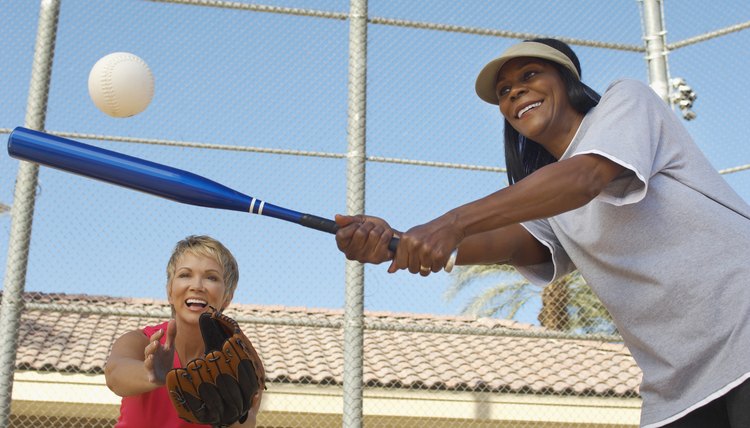How to Hit a Home Run in Softball

Hitting with power in competitive softball takes a high degree of skill and experience. Batters have to understand what the pitcher is trying to accomplish and then combat that battle plan with the perfect swing. Strength, hand-eye coordination, timing and athleticism are all factors that come into play when attempting to hit a home run in softball. The speed of the pitch is just one factor to overcome and so is the deceptiveness that pitchers bring to the mound.
Load your swing before you attack the ball. Some coaches call this negative movement. To hit for power, you must bring all your strength and momentum to your front side as you make contact with the ball. To get your body weight and momentum to the front, you need it on your back foot before you begin your swing. As the pitcher begins the windup, most of your weight should be on your back leg (the right leg for a right-handed batter) and then you should trigger your swing by bringing it forward as the pitch comes in.
Use your hips to generate power. Your hands and arms will send the bat through the hitting zone. However, the power will come from your hips when you swing. You must pivot your hips with quickness and purpose. Maintain your balance, or you will have no shot at driving the ball over the fence.
Develop a rhythm and a tempo to your swing. You want your swing to be one continuous motion that builds in pace as you swing the bat through the hitting zone. Start slow and end quickly. Do not stop and start in your swing or you will lose all momentum.
Track the ball with your eyes from the moment the pitcher begins her windup to the moment your bat hits the ball. A sharp focus on the ball is essential. Do not move your head to follow the pitch. To drive the ball, you must hit it with the sweet spot of the barrel of the bat. To do this, you must watch the ball the entire way to the plate.
Strengthen your body and condition yourself so you're ready for a peak performance every time you step into the batter's box. Weight training is a great way to get stronger. Circuit-training exercises will help strengthen your shoulders, arms, chest, abs, glutes, hamstrings and calf muscles. All of these will help you develop power and allow you to hit the home run. If you don't have access to circuit-training equipment, you can get stronger by doing pushups, pullups and crunches.
Tips
Don't swing with 100 percent effort if you can't control the bat at that speed. As a rule of thumb, use the maximum possible effort that allows you to keep your head still and track the pitch all the way to the plate.
Warnings
Don't try for a home run too often. Trying to hit home runs often leads to weak pop-ups or short fly balls.
References
Tips
- Don't swing with 100 percent effort if you can't control the bat at that speed. As a rule of thumb, use the maximum possible effort that allows you to keep your head still and track the pitch all the way to the plate.
Warnings
- Don't try for a home run too often. Trying to hit home runs often leads to weak pop-ups or short fly balls.
Writer Bio
Steve Silverman is an award-winning writer, covering sports since 1980. Silverman authored The Minnesota Vikings: The Good, The Bad and The Ugly and Who's Better, Who's Best in Football -- The Top 60 Players of All-Time, among others, and placed in the Pro Football Writers of America awards three times. Silverman holds a Master of Science in journalism from the Medill School of Journalism.
